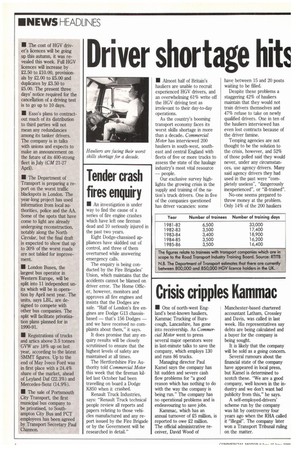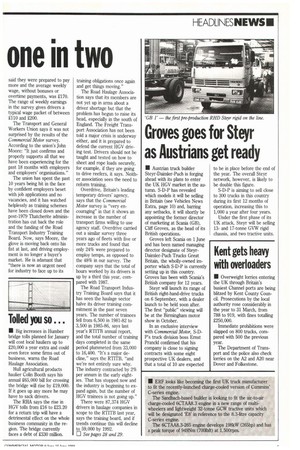Driver shortage hits one in two
Page 8

Page 9

If you've noticed an error in this article please click here to report it so we can fix it.
• Almost half of Britain's hauliers are unable to recruit experienced HGV drivers, and an overwhelming 61% write off the HGV driving test as irrelevant to their day-to-day operations.
As the country's booming transport economy faces its worst skills shortage in more than a decade, Commercial Motor has interviewed 200 hauliers in south-west, southeast and central England with fleets of five or more trucks to assess the state of the haulage industry's most vital resource — people.
Our exclusive survey highlights the growing crisis in the supply and training of the nation's truck drivers. One in five of the companies questioned has driver vacancies: some have between 15 and 20 posts waiting to be filled.
Despite these problems a staggering 42% of hauliers maintain that they would not train drivers themselves and 47% refuse to take on newly qualified drivers. One in ten of the hauliers interviewed has even lost contracts because of the driver famine.
Temping agencies are not thought to be the solution to the crisis, however, and 52% of those polled said they would never, under any circumstances, use agency drivers. Many said agency drivers they had used in the past were "completely useless", "dangerously inexperienced", or "ill-trained".
No-one seems prepared to throw money at the problem. Only 14% of the 200 hauliers said they were prepared to pay more and the average weekly wage, without bonuses or overtime payments, was 2170. The range of weekly earnings in the survey gives drivers a typical wage packet of between 2110 and .2200.
The Transport and General Workers Union says it was not surprised by the results of the Commercial Motor survey. According to the union's John Moore: "It just confirms and properly supports all that we have been experiencing for the past 18 months with employers and employers' organisations."
The union has spent the past 10 years being hit in the face by confident employers beset with job applications and no vacancies, and it has watched helplessly as training schemes have been closed down and the post-1979 Thatcherite administration has cut back the role and the funding of the Road Transport Industry Training Board. Now, says Moore, the glove is moving back onto his fist at last, and driving employment is no longer a buyer's market. He is adamant that "there is now an urgent need for industry to face up to its training obligations once again and get things moving."
The Road Haulage Association says that its members are not yet up in arms about a driver shortage but that the problem has begun to raise its head, especially in the south of England. The Freight Transport Association has not been told a major crisis is underway either, and it is prepared to defend the current HGV driving test. Drivers should not be taught and tested on how to sheet and rope loads securely, for example, if they are going to drive reefers, it says. Neither association sees the need to reform training.
Overdrive, Britain's leading temporary drivers' agency, says that the Commercial Motor survey is "very encouraging" in that it shows an increase in the number of transport firms willing to use agency staff. Overdrive carried out a similar survey three years ago of fleets with five or more trucks and found that only 24% were prepared to employ temps, as opposed to the 48% in our survey. The company says that the total of hours worked by its drivers is up by a third this year, compared with 1987.
The Road Transport Industry Training Board says that it has seen the haulage sector halve its driver training commitment in the past seven years. The number of trainees fell from 6,500 in 1981-82 to 3,500 in 1985-86, says last year's RTITB annual report, and the total number of training days completed in the same period plummeted from 33,000 to 16,400. "It's a major decline," says the RTITB, "and we're not entirely sure why. The industry contracted by 2% per annum in the early eighties. That has stopped now and the industry is beginning to expand again, but the number of HGV trainees is not going up."
There were 87,374 HGV drivers in haulage companies in scope to the RTITB last year, says the training board, and if trends continue this will decline to 59,000 by 1992. 0 See pages 28 and 29.
















































































































